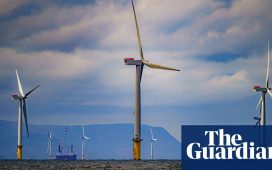If in doubt, throw cash at the shareholders. It’s a safe tactic for a new chief executive assailed on two sides by investors with conflicting grumbles. BP’s Murray Auchincloss seized his debut moment. There will be $3.5bn of share buy-backs in the first half of this year, accelerating to a total of $14bn by the end of next. The shares rose 5%. For a week or two, that might stop people pointing out how BP’s share price has lagged its peers’.
Yet shareholders of all hues – those who want to transition faster out of fossil fuels and those who can’t see the point – surely also wanted to hear a clear statement from Auchincloss on where he stands in the great debate. How will BP prioritise its spending of cash that isn’t going on buy-backs and dividends?
Does the BP CEO intend to stick rigidly to his predecessor, Bernard Looney’s, pursuit of net zero by 2050, a plan that included a cut of 25% in oil and gas production by 2030 against 2019 levels, accompanied by a ramp-up in spending in renewables and other “transition growth engines” in BP-speak? Or does he feel obliged to throw red meat to the lobby, now led by the small but influential hedge fund Bluebell Capital Partners, that says BP should stick to what it knows and leave the building of windfarms to specialists?
Auchincloss fudged it. “We will pragmatically adapt to what’s happening with demand in society,” he said, saying BP would go for the “highest return and highest value projects”. What does that mean?
Well, “pragmatic” in the mouth of a chief executive of a large oil company is often code for oilier than previously advertised. That is especially so when there’s a reference to the pace at which society is moving – a line used by Shell’s boss, Wael Sawan, to justify diluting green targets last year.
On the other hand, Auchincloss also played the continuity card. “Our destination remains unchanged”, he said, arguing BP still wanted to be an integrated energy company rather than an international oil company. Not all high-value projects, he seemed to imply, involve fossil fuels.
There was something for everyone, in other words. Those shareholders who protested a year ago about Looney cutting the oil and gas reduction target from 40% can console themselves that his successor hasn’t explicitly moved the dial further (he just talked about “aims” for 2030 rather than a “target”). And the Bluebellists can seize on the comments about “pragmatism” and think BP can be bounced into taking a more roundabout route to Auchincloss’s supposedly unchanged destination.
One can see why a new boss, even one who was the old finance director, might opt for ambiguity. When BP can actually show, rather than talk about, double-digit returns on capital from its investments in wind, solar, hydrogen and electric vehicle charging points, he will be in a stronger position.
Yet it’s hard to avoid the conclusion that absolute clarity would be a better approach when a debate over strategy is raging outside. This column’s view is that BP should be given time, which means at least a couple of years, to prove that decent returns can be generated outside fossil fuels. And since the plan imagines that three-quarters of earnings will still be coming from hydrocarbons in 2030, it is hardly a case of green evangelism in action.
But, quite obviously, not everyone agrees. The stick-to-what-you-know activists are getting louder. Rather than muddying the waters by hinting at tweaks and adjustments, Auchincloss should be braver. Say what you believe.










